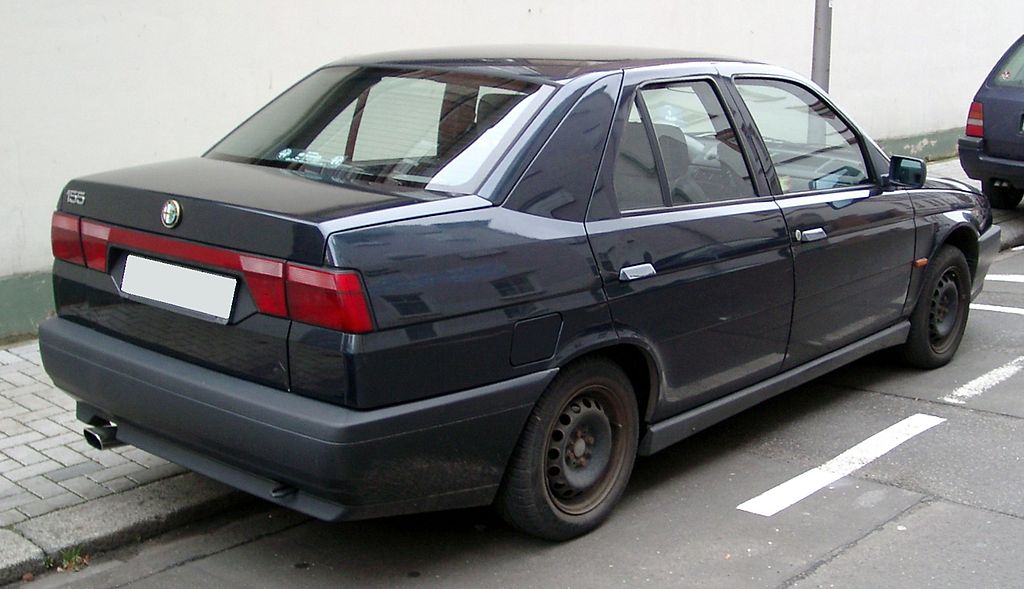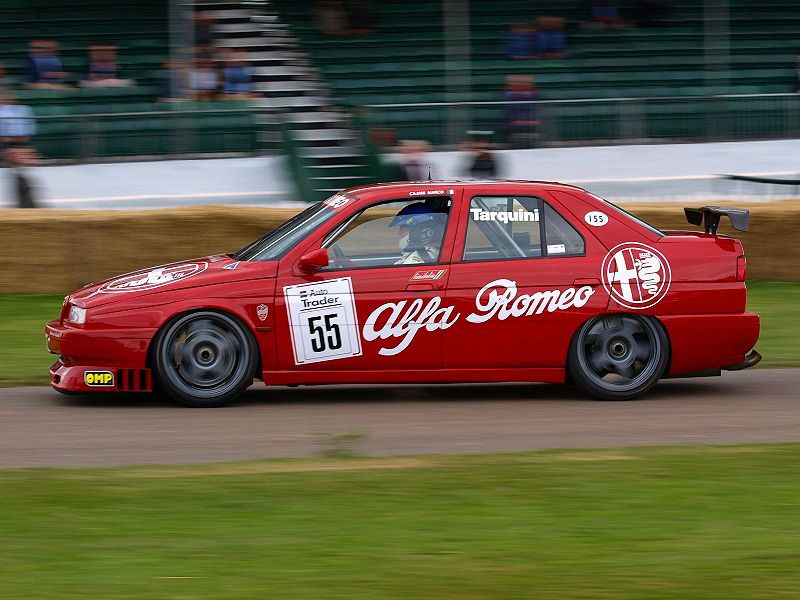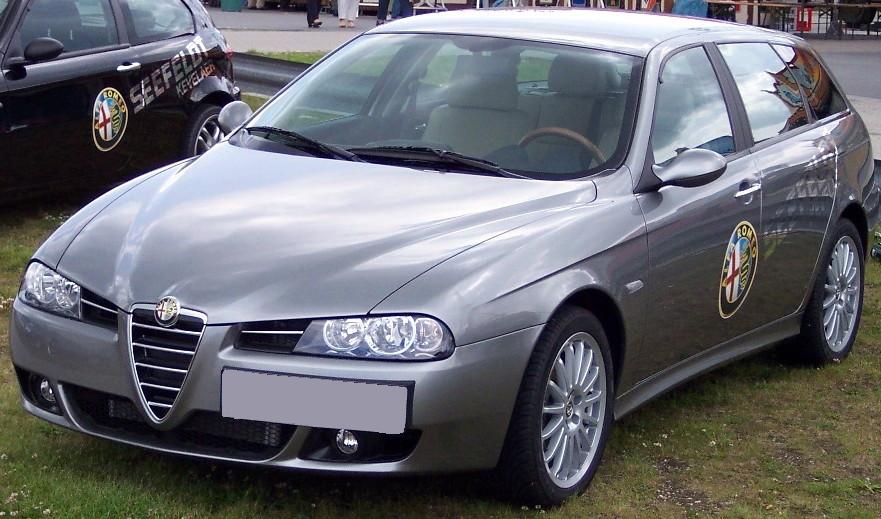1992-1998 155
The Alfa Romeo 155 (Type 167) is a compact executive car produced by the Italian manufacturer Alfa Romeo between 1992 and 1998. It was released in January 1992 in Barcelona, and the first public launch was in March 1992, at the Geneva Motor Show. It was built in 192,618 units.
1992 – 155 launched
1993 – Grill changed from “flushed” to “recessed”
1994 – 155 Silverstone introduced to the British market, 155 Q4 and turbodiesels to some markets
1995 – New "widebody" series 2 155 launched with wider track, initially only with 2.0 16v engine. Quickrack fitted
1996 – Widebody with 1.8 16v engine introduced
1998 – Production ends
1994-2000 145
1994-2000 146
The Alfa Romeo 145 (Tipo 930A) and the Alfa Romeo 146 (930B) are small family cars produced by Italian automobile manufacturer Alfa Romeo in Pomigliano d'Arco, Italy between 1994 and 2000. The 145 is a three door hatchback and was launched at the 1994 Turin Motor Show, while the 146 is a five door hatchback, launched in 1995 to replace the Alfa Romeo 33.
The 145 and 146 share design plans and interior components from the B-pillar forwards. 221,037 145s and 233,295 146s were built.
Development of Tipo 930, the replacement for the ageing 33 in the competitive family hatchback market, lasted four years. The first offspring of the project, the three door 145, made its début on static display at the April 1994 Turin Motor Show and then at the Paris Motor Show in July; a simultaneous European commercial launch was planned for 9 September, but it was delayed until October.
It was only in April 1992 that work had begun on a second car, the 146 or Tipo 930B, derived from and to be sold alongside the 145; with its more traditionally Alfa Romeo style it was aimed at a different clientele, that of the outgoing Alfa Romeo 33. The 146 premiéred in November 1994 at the Bologna Motor Show and went on sale in May 1995.
At launch, the engine line up for both cars comprised a 1.9 litre inline four turbo diesel and the boxer petrol engines from the 33, in 1.3[a] 8 valve, 1.6 8 valve and range topping 1.7 16 valve forms. Depending on the market, the engines were available in either or both base and better equipped L (for "Lusso") trim levels; L trim standard equipment was richer on larger engined cars.
1995-2006 GTV/Spider
The Alfa Romeo GTV (Gran Turismo Veloce—English: Fast Grand Touring) and Alfa Romeo Spider were two sports cars produced by the Italian manufacturer Alfa Romeo from 1995 to 2006. It is also known by Alfa Romeo's internal designation 916. The GTV is a 2+2 coupé, and the Spider is a two-seater roadster version of the GTV. Around 39,000 Spider and 41,700 GTVs were built from 1993 to 2004.
The GTV's name placed it as the successor to the long-discontinued Alfetta GTV coupé, whereas the Spider was effectively the replacement for the then 30-year-old 105-series Giulia Spider. The GTV was available until the launch of the Brera in 2005, while the Spider lasted another year until the launch of its Brera-based successor in 2006.
Alfa Romeo GTV is claimed as the best sport car by Jeremy Clarkson in 1998 and is listed at no. 29 in Top 100 Cars from 2001.
The GTV was initially offered with 2.0 TS or 2.0 V6 Turbo, while Spider with 2.0 TS or 3.0 V6 12V.
The exterior design was finished in July 1988. Production began in late 1993 with four cars, all 3.0 V6 Spiders, assembled at the Alfa Romeo Arese Plant in Milan. In early 1994 the first GTV was produced, with 2.0 Twin Spark engine. The first premiere was then held at the Paris Motor Show in 1994. The GTV and Spider were officially launched at the Geneva Motor Show in March 1995 and sales began the same year.
1997-2005 156
The Alfa Romeo 156 (Tipo 932) is a compact executive car produced by the Italian automobile manufacturer Alfa Romeo. This range of vehicles were manufactured between 1996 and 2007 while the 156 saloon was discontinued in Europe late in 2005, leaving the Q4 Crosswagon to continue in production until the end of 2007.
Introduced at the 1997 Frankfurt Motor Show as the replacement for the Alfa Romeo 155 the 156 was well accepted and in the following year went on to win the 1998 European Car of the Year award
Cars were assembled at the Fiat Group factory in Pomigliano d'Arco, Italy and at a General Motors facility in Rayong, Thailand. Production in Thailand began in March 2002 and ran for only a couple of years and vehicles produced there were targeted for the Asia Pacific markets). Between 1997 and 2005, approximately 680,000 vehicles designated 156s were produced.
The 156 was available in saloon, Sportwagon estate and Crosswagon crossover bodystyles with seven engine configurations; it went through two facelifts, first in 2002 and then in 2003. The Sportwagon advertising campaign was made with actress Catherine Zeta-Jones.
In 2007 the 159 became the replacement for the 156. This replacement vehicle went on to also spawn the Brera, the two door coupe that replaces the Alfa Romeo GTV along with its convertible sister the new Spider.
1998-2007 166
The Alfa Romeo 166 (Type 936) is an executive car produced by the Italian automaker Alfa Romeo, between October 1998 and June 2007. The car was designed by Centro Stile Alfa Romeo, under the control of Walter de Silva, and was facelifted in September 2003.
The 166 was the replacement for the Alfa Romeo 164, and although the 164 had styling which was far from orthodox, the 166, with its drooping headlamps and pointed nose, still raised many eyebrows. The styling was very much in keeping with Alfa's corporate style of the time, which had begun with the smaller 156 model.
Production began in the end of 1996, and model was available from 1998. In total, around 100,000 cars were produced.
The car was initially available with a 2.0 litre Twin Spark (155 PS), a 2.5 V6 (190 PS), a 3.0 V6 (226 PS) or a V6 2.0 Turbo (205 PS) petrol engine. Diesel engines were a L5 2.4 10v common rail turbodiesel version with 136 PS (100 kW; 134 hp), 140 PS (103 kW; 138 hp) and 150 PS (110 kW; 148 hp) output, praised for its refinement.
The TS model used a five speed manual gearbox, whilst the 2.5 and 3.0 had the option of a Sportronic automatic gearbox. The 3.0 V6, L5 2.4 and V6 Turbo were otherwise supplied with a six speed manual gearbox.
The top models were named "Super", and included MOMO leather interior, 17" alloy wheels, rain sensitive wipers, cruise control, climate control and ICS (Integrated Control System) with colour screen. Options included xenon headlamps, GSM connectivity and satellite navigation.
Suspension systems comprised double wishbones at the front, and a multi link setup for the rear. Though the car's handling characteristics, engine range and elegant exterior design received praise from many, including Top Gear's Jeremy Clarkson, it did not become a strong seller to rival the dominant German brands, in the European executive car sector.






_(rear)%2C_Serdang.jpg/1280px-Alfa_Romeo_146_(first_generation)_(rear)%2C_Serdang.jpg)

















.jfif)
No comments:
Post a Comment